- Last week, cryptoassets continued to underperform due to declining risk appetite across
assets and ongoing profit-taking by long-term bitcoin holders.
- Last week, cryptoassets continued to underperform due to declining risk appetite across
assets and ongoing profit-taking by long-term bitcoin holders.
- Chart of the Week: The Crypto Fear & Greed Index reached a level of 10 (“extreme fear”) for
the first time since February 2025 signalling widespread bearishness among investors. It is
worth noting that the current level of the Crypto Fear & Greed index is already comparable
with events like the FTX insolvency in November 2022 or the Covid crash in March 2020, i.e.
excessively bearish.
Chart of the Week
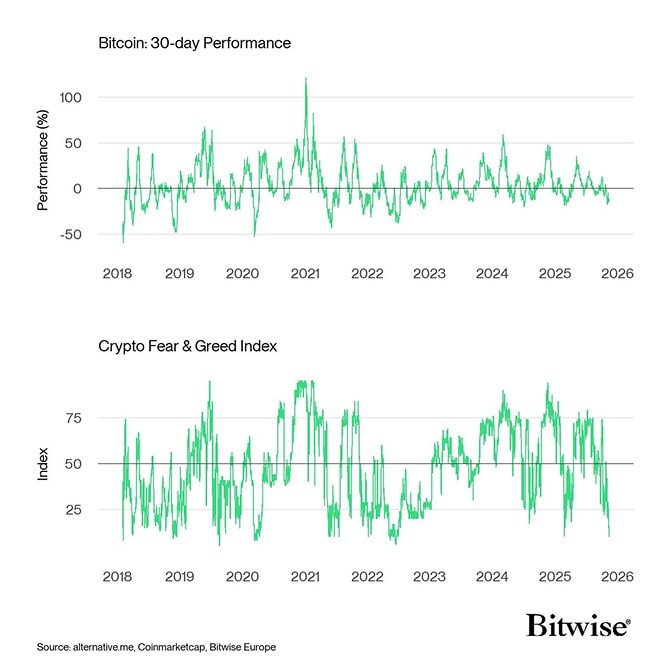
Performance
Last week, cryptoassets continued to underperform due to declining risk appetite
across assets and ongoing profit-taking by long-term holders.
Bitcoin’s year-to-date performance has officially turned negative as well
which was seen as a negative sign as well – the first post-Halving years have never seen a negative
performance before.
One of the key headwinds appears to be continued profit-taking by long-term
holders of bitcoin. Long-term holders are defined as investors with a holding period of more than 155 days.
These investors continued to offload around -186k bitcoins in November alone.
The overall market sentiment was also affected negatively by rumours that Michael
Saylor’s Strategy Inc. (MSTR) might have started selling bitcoins. However, these on-chain transfers
appear to be tied to internal wallet reorganisations rather than actual sales.
To the contrary, Michael Saylor has publicly
stated that MSTR has bought significantly more bitcoins last week
than in previous weeks.
Furthermore, many sentiment indicators continue to signal very bearish sentiment
and therefore limited downside risks.
For instance, the original Crypto Fear & Greed Index published by alternative.me reached a
level of 10 (“extreme fear”) for the first time since February 2025 signalling widespread
bearishness among investors (Chart-of-the-Week).
The index has spent the whole month of November in either “fear” or
“extreme fear” territory so far.
It is worth noting that the current level of the Crypto Fear
& Greed index is already comparable with events like the FTX insolvency in November 2022 or the Covid
crash in March 2020, i.e. excessively bearish.
What is worth noting though is that the Crypto Fear & Greed Index is a contrarian indicator
- very low readings below 20 have consistently signalled positive above-average forward returns in the past
as shown here.
Moreover, our in-house Cryptoasset Sentiment Indicator has
continued to signal a bearish sentiment but with a so-called “bullish divergence” which means
that underlying sentiment metrics have been declining less despite lower prices implying increasing seller
exhaustion in different areas of the market.
In general, we think that fears of a cycle top are overblown due to the
following reasons:
- Global liquidity growth continues to expand due to aggressive
rate cuts by major central banks worldwide – this tends to lead the global business cycle and risk
appetite in bitcoin by around 6-9 months.
- The Halving-induced supply deficit has become less relevant than
institutional demand via global treasury companies and ETPs which is why this cycle’s performance
pattern is unlikely to resemble past post-Halving performance patterns.
- Bitcoin valuations have not been excessive this cycle, and we
haven’t seen a significant blow-off- top, yet. In fact, bitcoin valuations now signal an
undervaluation of bitcoin.
This is why we continue to regard the current market environment as an attractive
opportunity to increase rather than to decrease exposure to bitcoin and other major cryptoassets.
We rather regard the current drawdown as an interim bull market correction rather
than a drawdown into an ensuing bear market.
Cross Asset Performance (Week-to-Date)
 Source: Bloomberg, Coinmarketcap; performances in USD exept Bund Future
Top 10 Cryptoasset Performance (Week-to-Date)
Source: Bloomberg, Coinmarketcap; performances in USD exept Bund Future
Top 10 Cryptoasset Performance (Week-to-Date)
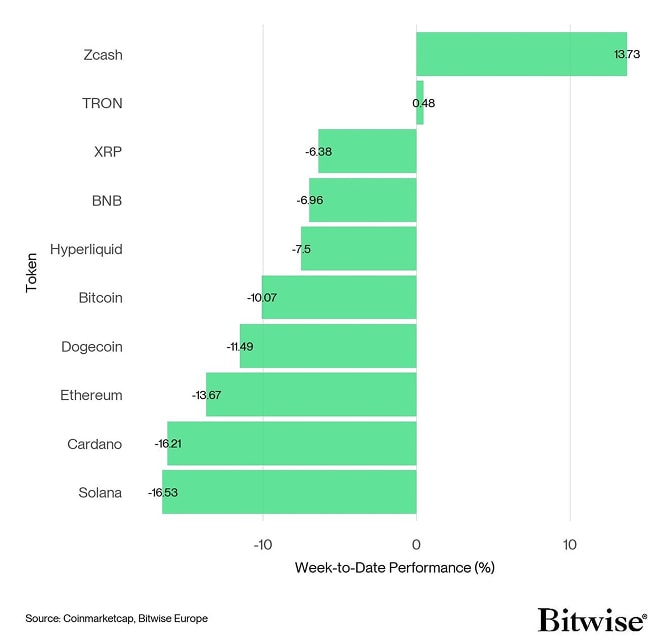 Source: Coinmarketcap
Source: Coinmarketcap
In general, among the top 10 crypto assets Zcash, TRON, and XRP were the relative
outperformers.
Overall, altcoin outperformance vis-à-vis bitcoin has continued to be
relatively high last week, with 55% of our tracked altcoins managing to outperform bitcoin on a weekly
basis. However, Ethereum continued
to underperform bitcoin last week.
Sentiment
Our in-house “Cryptoasset Sentiment
Index” has continued to exhibit bearish sentiment but with a so-called
“bullish divergence” which means that underlying sentiment metrics have been declining less
despite lower prices implying increasing seller exhaustion in different areas of the market.
At the moment, 6 out of 15 indicators are above their short-term trend.
Last week, the Crypto Dispersion Index and the Hedge Fund Beta metrics showed
positive momentum.
The Crypto Fear & Greed Index currently signals a “extreme fear”
level of sentiment as of this morning.
The index has spent the whole month of November in either “fear” or “extreme fear”
territory so far.
Performance dispersion among cryptoassets has
continued to trend up slightly last week as cryptoassets like Zcash have decoupled from the negative
performance of bitcoin. This means that the market appears to be driven by a more diverse set of narratives
which tends to be a sign of increasing risk appetite.
Altcoin outperformance vis-à-vis Bitcoin has
continued to be relatively high last week, with around 55% of our tracked altcoins managing to outperform
Bitcoin on a weekly basis. Nonetheless, Ethereum continued to underperform Bitcoin last week.
In general, increasing (decreasing) altcoin outperformance tends to be a sign of
increasing (decreasing) risk appetite within cryptoasset markets and the latest altcoin outperformance still
signals increasing risk appetite at the moment.
Sentiment in traditional financial markets as measured by our
in-house measure of Cross Asset Risk Appetite (CARA) declined
slightly, moving from 0.36 to 0.21. This is a notable divergence between TradFi and crypto asset sentiment
that should be watched closely.
Fund Flows
Global crypto ETPs continued to see significant outflows last week. However, it
should be noted that excessive outflows tend to be a contrarian signal on its own.
Global crypto ETPs saw around -1864.3 mn USD in weekly
net outflows across all types of cryptoassets, after -1486.5 mn USD in net outflows the previous
week.
Global Bitcoin ETPs have
continued to experience net
outflows totalling -1147.7 USD last week, of which -1114.8 mn USD in net outflows were related to
US spot Bitcoin ETFs.
The Bitwise
Bitcoin ETF (BITB) in the US experienced net outflows, totalling -38.6
mn USD last week.
In Europe, the Bitwise
Physical Bitcoin ETP (BTCE) experienced net outflows equivalent to -6.5
mn USD, while the Bitwise
Core Bitcoin ETP (BTC1) experienced minor net inflows of +1.3 mn
USD.
The Grayscale Bitcoin Trust (GBTC) has posted net outflows of -112.6 mn USD and the
iShares Bitcoin Trust (IBIT) also experienced net outflows of around -532.4 mn USD last week.
Meanwhile, flows into
global Ethereum ETPs also
experienced net outflows last week, with around -730.8 mn
USD in net outflows.
US spot Ethereum ETFs, also recorded net outflows of around
-728.6 mn USD on aggregate. The Grayscale Ethereum Trust (ETHE), has posted net outflows of -121.9 mn
USD.
The Bitwise
Ethereum ETF (ETHW) in the US has also posted net outflows of -4.4 mn
USD.
In Europe, the Bitwise
Physical Ethereum ETP (ZETH) saw minor net inflows of +0.1 mn USD while
the Bitwise
Ethereum Staking ETP (ET32) also saw net inflows of +1.1 mn USD.
Altcoin ETPs ex Ethereum experienced net outflows of
-26.4 mn USD last week despite strong inflows into Solana ETFs in the US.
Thematic & basket crypto ETPs, however, posted net
inflows of +40.6 mn USD on aggregate last week. The Bitwise
MSCI Digital Assets Select 20 ETP (DA20) has experienced minor net
inflows (+0.3 mn USD) on aggregate.
Global crypto hedge funds exposure to Bitcoin continued
to increase last week. The 20-days rolling beta of global crypto hedge funds’ performance to Bitcoin
increased to around 0.80 per yesterday’s close, up from 0.74 from the week before.
On-Chain Data
Sell-side pressure across exchanges has surged, with intraday spot buying minus
selling falling from –$477mn to –$3.3bn, marking one of the largest readings on record. At the
same time, on-chain profit taking remains elevated at around $620mn per day, but is beginning to moderate,
suggesting that the pace of investor de-risking is showing the first signs of exhaustion.
Across the downtrend, Short-Term Holders continue to lock in losses, realising
-$5.1bn over the past 30 days. The scale of these realised losses is now approaching those seen during the
tariff tantrum, which remains the largest loss-taking event of the cycle under this metric, peaking at
-$5.4bn.
Additionally, we can utilise the SOPR metric to assess the average profit or loss
multiple locked in across all coins spent each day. Notably, the metric has returned to its equilibrium
value of 1.0, suggesting that overall investor spending behaviour is now balanced and that the market has
reset to a position of neutrality. It would be constructive to see the metric hold above 1.0, which would
indicate that investors are defending their cost basis and that the market is avoiding a transition into a
loss-dominant regime.
Increasing our granularity, we can assess the SOPR multiple for the Long-Term
Holder (LTH) cohort, which reflects the spending behaviour of mature market participants. As of current, LTH
SOPR has declined to 1.38 (+38% profit per coin), its lowest reading since December 2023. This suggests a
potential exhaustion of mature investor spending within the current price range and is likely a key
contributor to the recent moderation in overall profit taking.
The AVIV Ratio, which measures investor sentiment through the lens of the average
paper profit or loss held by active market participants continues to decline, with aggregate paper gains now
around 15%, the lowest reading since November 2023. Furthermore, the AVIV Ratio has fallen below its
long-term mean of 20%. This remains a key level to reclaim for investor sentiment to remain
constructive.
In addition, the market is now decisively below the $100k level, which is both a
key technical and psychological threshold, and remains critical to reclaim to preserve bull market
structure. The $93.5k level is also essential, as it marks the lower bound of the on-chain volume profile.
Beneath this point lies an air-gap region where relatively few coins have exchanged hands, implying thinner
support should price move lower. This makes $93.5k a crucial level to defend, since losing it could lead to
a more pronounced breakdown in overall bull market structure.
All in all, on-chain conditions suggest that the market resides at a critical
inflection point, with several key sentiment indicators such as the AVIV ratio continuing to decline and
breaking below its long-term mean. Sell-side pressure across exchanges has surged to -$3.3bn, while on-chain
profit taking of around +$620mn per day shows that investors continue to de-risk, although the pace is
beginning to moderate. Short-Term Holders have realised -$5.1bn in losses over the past 30 days, approaching
the scale of the tariff tantrum event, while SOPR has returned to its neutral level of 1.0, indicating that
on-balance, spending behaviour is largely neutral.
Most importantly, reclaiming the $100k level, and subsequently the 200-day moving
average and Short-Term Holder cost basis, will be essential for restoring constructive momentum, while
defending $93.5k remains critical given the air-gap of thin on-chain support beneath it, with a loss of this
level potentially resulting in a pronounced breakdown in overall bull market structure.
Futures, Options & Perpetuals
Over the past week, BTC perpetual futures open interest increased by 31.6k BTC
across all exchanges, while CME futures open interest rose by 1.9k BTC, signalling a modest uptick in
institutional participation. However, total open interest remains well below levels seen in prior months,
suggesting that traders continue to exercise caution following the recent market deleveraging.
BTC perpetual funding rates remain positive and have shown signs of initial
growth as investors attempt to long the perceived bottom. This indicates a cautious market stance rather
than signs of speculative excess.
In general, when the funding rate is positive (negative), long (short) positions
periodically pay short (long) positions, which is indicative of bullish (bearish) sentiment.
The BTC 3-months annualised basis continues to decline to 4.4% p.a., averaged
across various futures exchanges.
BTC options open interest has risen by approximately 32.1k BTC, while the put to
call open interest ratio has risen to 0.65. This suggests that appetite for downside protection remains
elevated and rising.
Notably, a large put wall resides at $95k, suggesting that put underwriters may
need to purchase spot BTC to hedge and defend their exposure. Alternatively, a loss of this level could
trigger an unwinding of these positions as underwriters reduce risk, underscoring the importance of $95k as
a crucial threshold for market stability.
Additionally, 25-delta skew across major BTC option tenors has continued to rise.
This suggests that near-term demand for downside protection is climbing, while longer-dated hedging appetite
remains elevated, indicating that investors are concerned about both immediate price risk and medium-term
uncertainty.
Bottom Line
- Last week, cryptoassets continued to underperform due to
declining risk appetite across assets and ongoing profit-taking by long-term bitcoin holders.
- Our in-house “Cryptoasset Sentiment Index” has
continued to exhibit bearish sentiment but with a so-called “bullish divergence” which means
that underlying sentiment metrics have been declining less despite lower prices implying increasing
seller exhaustion in different areas of the market.
- Chart of the Week: The Crypto Fear & Greed Index reached
a level of 10 (“extreme fear”) for the first time since February 2025 signalling widespread
bearishness among investors. It is worth noting that the current level of the Crypto Fear & Greed
index is already comparable with events like the FTX insolvency in November 2022 or the Covid crash in
March 2020, i.e. excessively bearish.
Appendix
Bitcoin Price vs Cryptoasset Sentiment Index
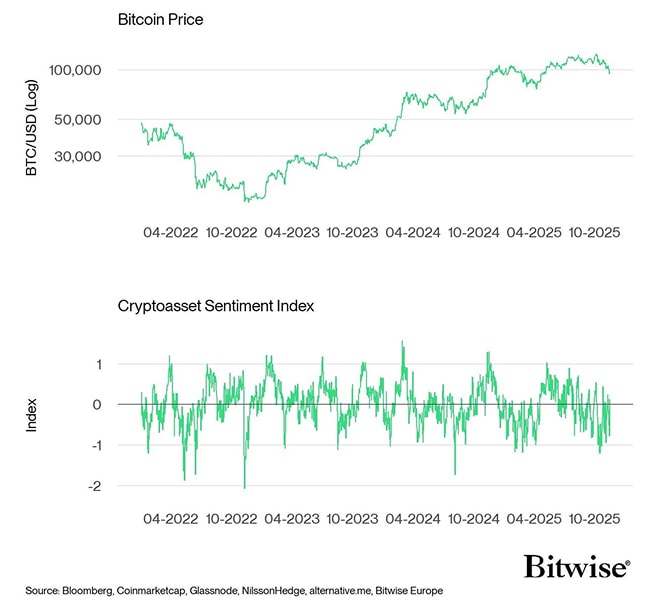 Source: Bloomberg, Coinmarketcap, Glassnode, NilssonHedge, alternative.me, Bitwise Europe
Cryptoasset Sentiment Index
Source: Bloomberg, Coinmarketcap, Glassnode, NilssonHedge, alternative.me, Bitwise Europe
Cryptoasset Sentiment Index
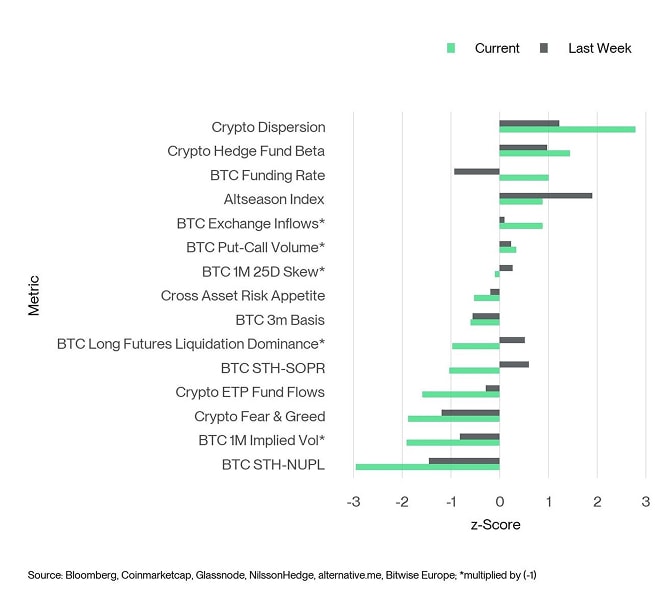 Source: Bloomberg, Coinmarketcap, Glassnode, NilssonHedge, alternative.me, Bitwise Europe; *multiplied by (-1)
Cryptoasset Sentiment Index
Source: Bloomberg, Coinmarketcap, Glassnode, NilssonHedge, alternative.me, Bitwise Europe; *multiplied by (-1)
Cryptoasset Sentiment Index
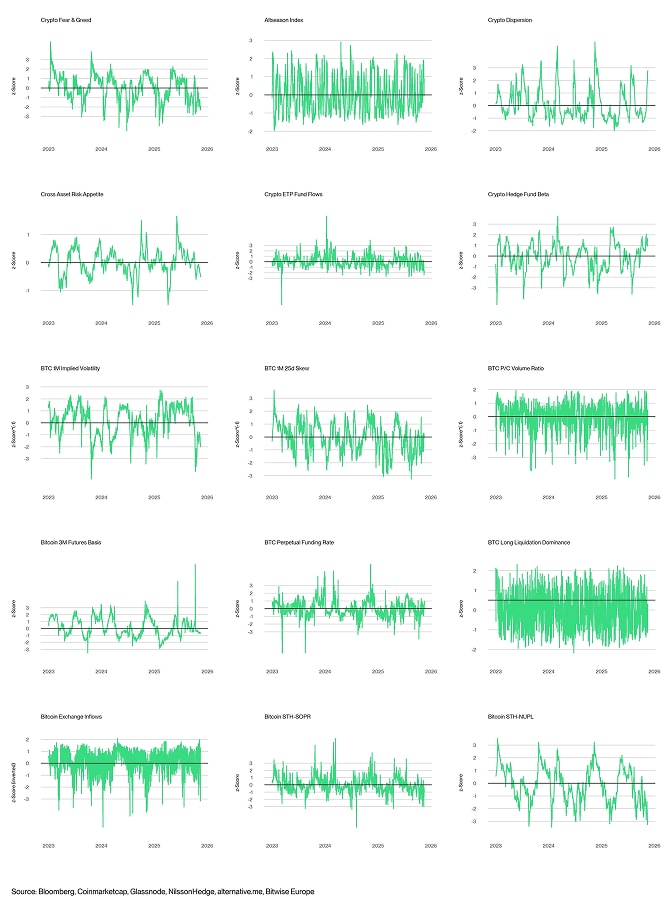 Source: Bloomberg, Coinmarketcap, Glassnode, NilssonHedge, alternative.me, Bitwise Europe
TradFi Sentiment Indicators
Source: Bloomberg, Coinmarketcap, Glassnode, NilssonHedge, alternative.me, Bitwise Europe
TradFi Sentiment Indicators
 Source: Bloomberg, NilssonHedge, Bitwise Europe
Crypto Sentiment Indicators
Source: Bloomberg, NilssonHedge, Bitwise Europe
Crypto Sentiment Indicators
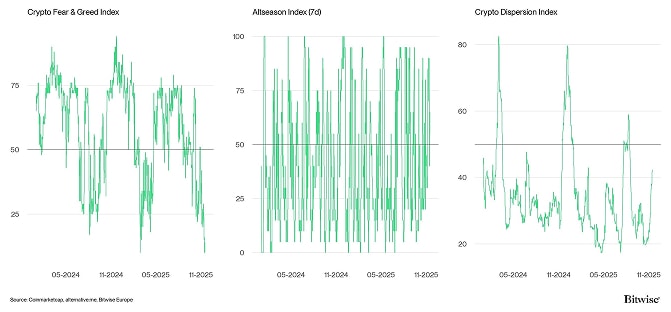 Source: Coinmarketcap, alternative.me, Bitwise Europe
Crypto Options' Sentiment Indicators
Source: Coinmarketcap, alternative.me, Bitwise Europe
Crypto Options' Sentiment Indicators
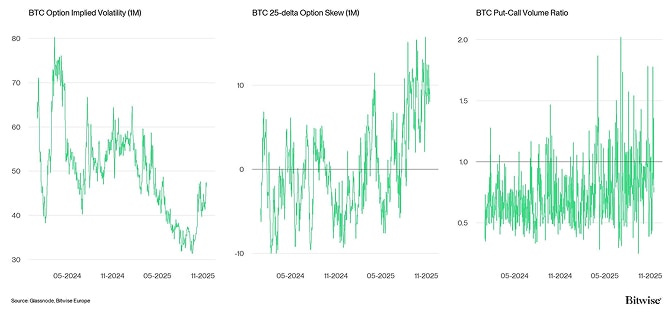 Source: Glassnode, Bitwise Europe
Crypto Futures & Perpetuals' Sentiment Indicators
Source: Glassnode, Bitwise Europe
Crypto Futures & Perpetuals' Sentiment Indicators
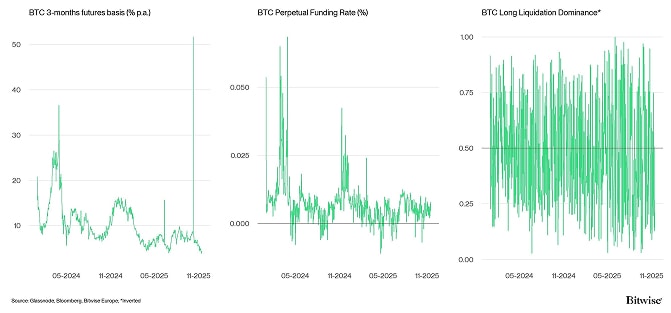 Source: Glassnode, Bitwise Europe; *Inverted
Crypto On-Chain Indicators
Source: Glassnode, Bitwise Europe; *Inverted
Crypto On-Chain Indicators
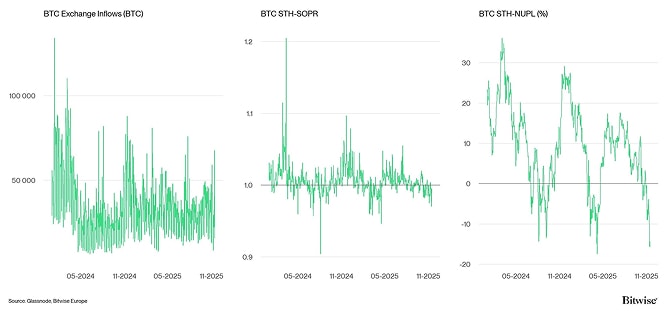 Source: Glassnode, Bitwise Europe
Bitcoin vs Crypto Fear & Greed Index
Source: Glassnode, Bitwise Europe
Bitcoin vs Crypto Fear & Greed Index
 Source: alternative.me, Coinmarketcap, Bitwise Europe
Cryptoasset Sentiment Index: Daily vs Hourly
Source: alternative.me, Coinmarketcap, Bitwise Europe
Cryptoasset Sentiment Index: Daily vs Hourly
 Source: Bloomberg, Coinmarketcap, Glassnode, NilssonHedge, alternative.me, CFGI.io, Bitwise Europe
Bitcoin vs Global Crypto ETP Fund Flows
Source: Bloomberg, Coinmarketcap, Glassnode, NilssonHedge, alternative.me, CFGI.io, Bitwise Europe
Bitcoin vs Global Crypto ETP Fund Flows
 Source: Bloomberg, Bitwise Europe; ETPs only, data subject to change
Global Crypto ETP Fund Flows
Source: Bloomberg, Bitwise Europe; ETPs only, data subject to change
Global Crypto ETP Fund Flows
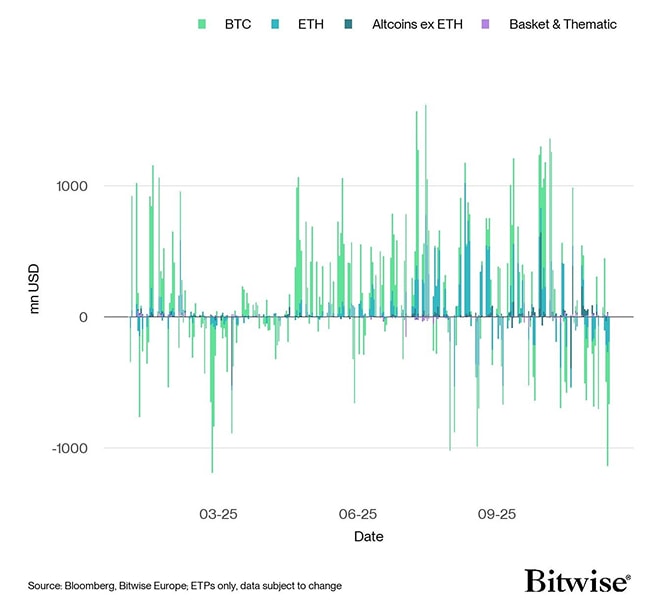 Source: Bloomberg, Bitwise Europe; ETPs only; data subject to change
US Spot Bitcoin ETF Fund Flows
Source: Bloomberg, Bitwise Europe; ETPs only; data subject to change
US Spot Bitcoin ETF Fund Flows
 Source: Bloomberg, Bitwise Europe; data subject to change
US Spot Bitcoin ETFs: Flows since launch
Source: Bloomberg, Bitwise Europe; data subject to change
US Spot Bitcoin ETFs: Flows since launch
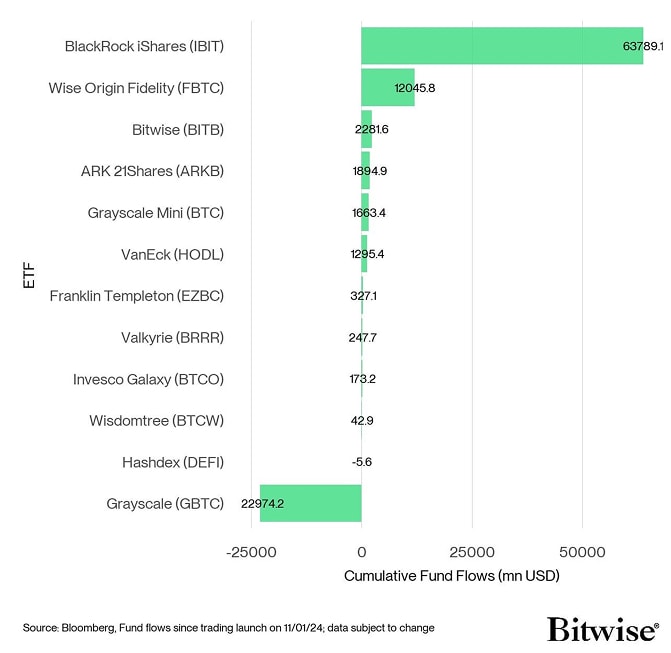 Source: Bloomberg, Fund flows since traiding launch on 11/01/24; data subject to change
US Spot Bitcoin ETFs: 5-days flow
Source: Bloomberg, Fund flows since traiding launch on 11/01/24; data subject to change
US Spot Bitcoin ETFs: 5-days flow
 Source: Bloomber; data subject to change
US Bitcoin ETFs: Net Fund Flows since 11th Jan mn USD
Source: Bloomber; data subject to change
US Bitcoin ETFs: Net Fund Flows since 11th Jan mn USD
 Source: Bloomberg, Bitwise Europe; data as of XX-XX-2025
US Spot Ethereum ETF Fund Flows
Source: Bloomberg, Bitwise Europe; data as of XX-XX-2025
US Spot Ethereum ETF Fund Flows
 Source: Bloomberg, Bitwise Europe; data subject to change
US Spot Ethereum ETFs: Flows since launch
Source: Bloomberg, Bitwise Europe; data subject to change
US Spot Ethereum ETFs: Flows since launch
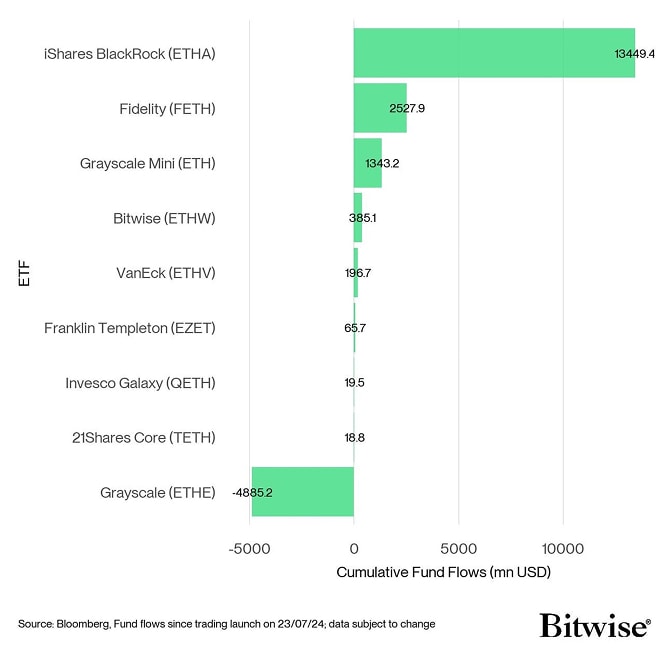 Source: Bloomberg, Fund flows since trading launch on 23/07/24; data subject on change
US Spot Ethereum ETFs: 5-days flow
Source: Bloomberg, Fund flows since trading launch on 23/07/24; data subject on change
US Spot Ethereum ETFs: 5-days flow
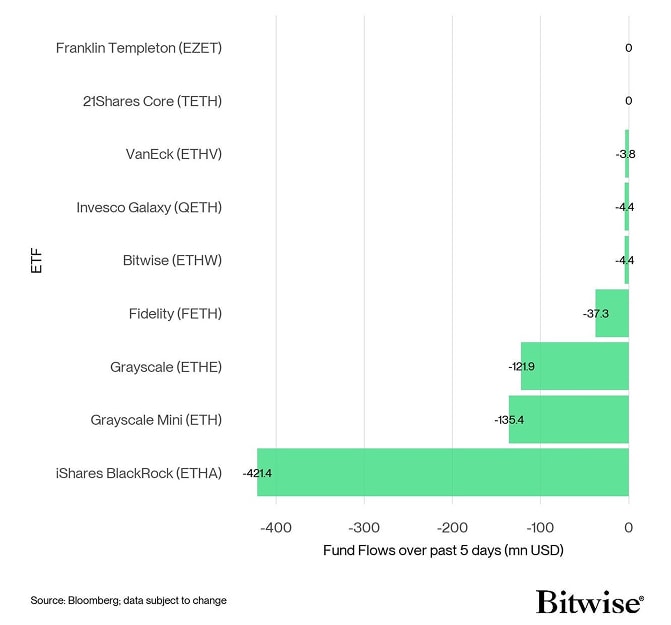 Source: Bloomberg; data subject on change
US Ethereum ETFs: Net Fund Flows since 23rd July
Source: Bloomberg; data subject on change
US Ethereum ETFs: Net Fund Flows since 23rd July
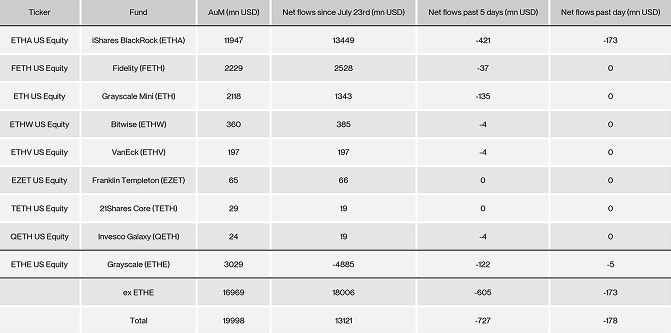 Source: Bloomberg, Bitwise Europe; data as of XX-XX-2025
Bitcoin vs Crypto Hedge Fund Beta
Source: Bloomberg, Bitwise Europe; data as of XX-XX-2025
Bitcoin vs Crypto Hedge Fund Beta
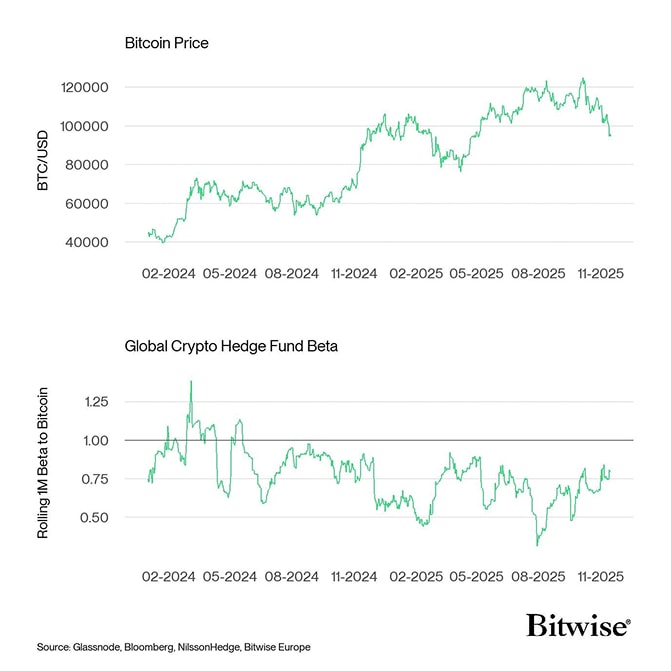 Source: Glassnode, Bloomberg, NilssonHedge, Bitwise Europe
Altseason Index
Source: Glassnode, Bloomberg, NilssonHedge, Bitwise Europe
Altseason Index
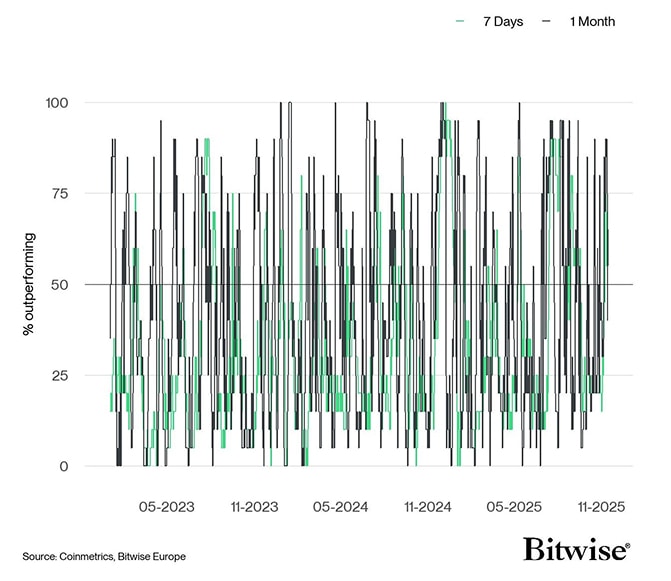 Source: Coinmetrics, Bitwise Europe
Bitcoin vs Crypto Dispersion Index
Source: Coinmetrics, Bitwise Europe
Bitcoin vs Crypto Dispersion Index
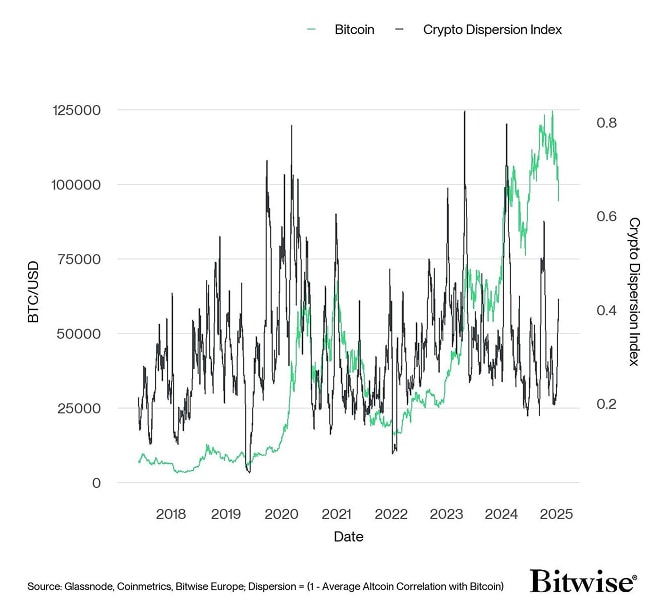 Source: Coinmarketcap, Bitwise Europe; Dispersion = (1 - Average Altcoin Correlation with Bitcoin)
Bitcoin Price vs Futures Basis Rate
Source: Coinmarketcap, Bitwise Europe; Dispersion = (1 - Average Altcoin Correlation with Bitcoin)
Bitcoin Price vs Futures Basis Rate
 Source: Glassnode, Bitwise Europe; data as of 2025-XX-XX
Ethereum Price vs Futures Basis Rate
Source: Glassnode, Bitwise Europe; data as of 2025-XX-XX
Ethereum Price vs Futures Basis Rate
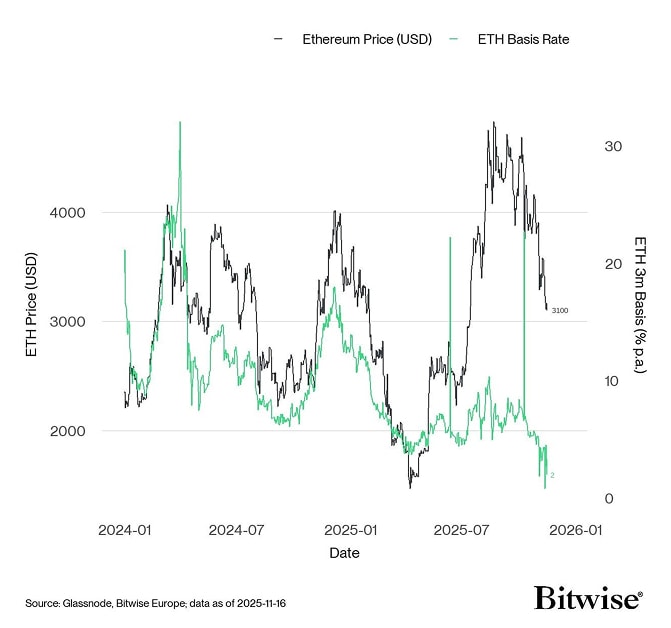 Source: Glassnode, Bitwise Europe; data as of 2025-XX-XX
BTC Net Exchange Volume by Size
Source: Glassnode, Bitwise Europe; data as of 2025-XX-XX
BTC Net Exchange Volume by Size
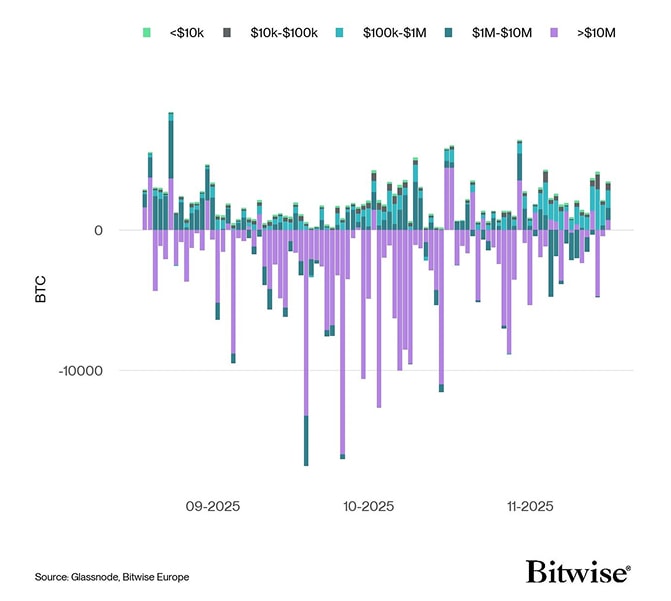 Source: Glassnode, Bitwise Europe
Source: Glassnode, Bitwise Europe
Important information:
This article does not constitute investment advice, nor does it constitute an offer or solicitation to buy financial products. This article is for general informational purposes only, and there is no explicit or implicit assurance or guarantee regarding the fairness, accuracy, completeness, or correctness of this article or the opinions contained therein. It is advised not to rely on the fairness, accuracy, completeness, or correctness of this article or the opinions contained therein. Please note that this article is neither investment advice nor an offer or solicitation to acquire financial products or cryptocurrencies.
Before investing in crypto ETPs, potentional investors should consider the following:
Potential investors should seek independent advice and consider relevant information contained in the base prospectus and the final terms for the ETPs, especially the risk factors mentioned therein. The invested capital is at risk, and losses up to the amount invested are possible. The product is subject to inherent counterparty risk with respect to the issuer of the ETPs and may incur losses up to a total loss if the issuer fails to fulfill its contractual obligations. The legal structure of ETPs is equivalent to that of a debt security. ETPs are treated like other securities.

